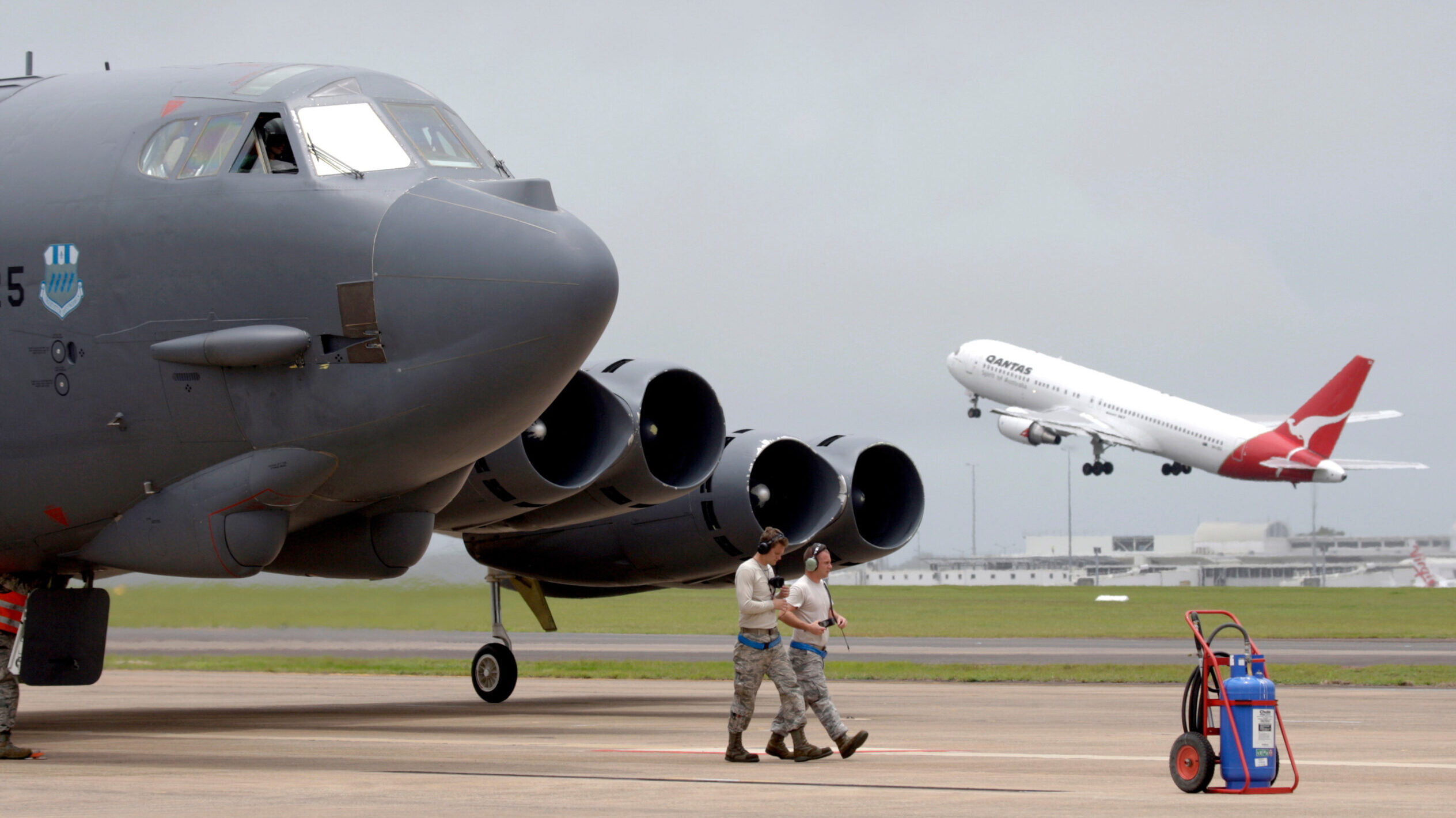
A US Air Force B-52 bomber stationed at Anderson Air Force Base, Guam, landed at Royal Australian Air Force (RAAF) Base Darwin in January 2014. (Leading Aircraftman Terry Hartin)
SYDNEY — With an announcement on the way forward for Australia’s nuclear submarine “imminent,” a Tuesday senate hearing provided a reminder that nuclear weapons remain a touchy subject among the Australian public and its politicians.
During the hearing, Foreign Minister Penny Wong and the Department of Defense’s secretary, Greg Moriarty, took fire from members of the Green Party over the question of whether American B-52s have been bringing nuclear weapons to Australian soil when the decade-old planes land in the Lucky Country. B-52s are expected to periodically visit Tindal Air Base in the country’s north, where the US has committed funding to improve the facilities.
It’s the first time the issue of US nuclear weapons in Australia has been raised publicly under this government. While a minority party, the Greens are aligned with Wong’s Labor party and control 11 of the 75 Senate seats, meaning Wong can’t just dismiss their concerns as the government prepares for a major moment for the AUKUS agreement.
Several Green senators pressed for answers, including David Shoebridge, a first-term senator who sits on the defense committee. He tried using Australia’s adherence to the Treaty of Rarotonga — also known as the South Pacific Nuclear Free Zone Treaty — to push the two officials on whether if Australia is complying with the treaty and also asking if visiting B-52s were nuclear capable.
Technically, all B-52Hs are nuclear capable. They may no longer carry nuclear gravity bombs, but they can be armed with nuclear-tipped cruise missiles. US policy is to neither confirm nor deny the presence of nuclear weapons.
RELATED: Growing signs Australia’s new nuclear sub will be British design
“I think more generally, it’s clear stationing of nuclear weapons in Australia is prohibited by the South Pacific nuclear free zone treaty, to which Australia is fully committed. There is no impediment under this treaty or the Nuclear Non Proliferation Treaty to the visit of foreign aircraft to Australian airfields or transit of Australia’s airspace, including in the context of our training and exercise programs, and the Australia and the Australian force posture cooperation with the United States,” Moriarty said.
“Australia’s long-standing arrangements to support visits by US strategic assets are consistent with our obligations under the South Pacific nuclear free zone trading,” he continued. “US bomber aircraft have been visiting Australia since the early 1980s and have conducted training in Australia since 2005. Successive Australian governments have understood and respected the longstanding US policy of neither confirming nor denying the presence of nuclear weapons on particular platforms. Australia will continue to fully comply with our international obligations, and the United States understand and respects Australia’s international obligations with respect to nuclear weapons.”
But Shoebridge was determined to make his point: “So, Mr. Moriarty, do I understand from that answer that defense does not believe that there is a restraint under Australia’s current treaty obligations meeting nuclear armed B-52 bombers to be present in Australia, provided it’s not a permanent presence?”
Wong would not have it and drew the exchanges to a close with this.
“I’m the minister, and I’m responding,” she said, a bit testily. “It is part of ensuring we maintain that interoperability that goes to us making Australia safe. We have tried to be helpful in indicating our commitment to the South Pacific nuclear free zone treaty. We are fully committed to that. And we’ve given you the answer that the secretary has given you. And I’m not going to engage in any more hypotheticals because I don’t actually think your questioning is anything more than trying to drum up concern, and I don’t think it’s responsible.”
So, basically, Australia accepts America’s policy of strategic ambiguity about whether or not its forces in any particular place have nuclear weapons, and that is unlikely to change. Neither answer was to the Green’s pleasure, but Shoebridge and his colleagues did not keep pressing.
Moriarty, asked about the just-completed Defense Strategic Review, said the defense budget was “under pressure” and raised the possibility that some large programs might be cut. Former defense force chief Sir Angus Houston and Stephen Smith presented the review Tuesday to Prime Minister Anthony Albanese and Defense Minister Richard Marles, but it will be at least several weeks before it is made public, Marles said Tuesday afternoon in an interview with the Australian Broadcasting Corporation.
“We’re very realistic about the challenges we face. The budget that we have is fully committed and the Defense Strategic Review will help us further sharpen those priorities and take hard decisions about what we need to focus on and what needs to be prioritized and perhaps even cut,” Moriarty said.
One of the interesting tidbits the secretary disclosed is that Australia used to assume it had a decade to respond to changing strategic imperatives. But “shrinking strategic warning times and rapidly advancing technology” now mean Australia must move much more quickly and place more emphasis on its own industrial base. The pressure from a rapidly modernizing Chinese military is clearly being felt.
In his interview, Marles confirmed that a major milestone for the AUKUS nuclear attack submarine program is nearing, saying a decision on the path forward is “imminent.” He added that “We’re in conversation with both the UK and the US around the manner in which that is ultimately announced and we expect that in the very near future.” That announcement is expected sometime in March.






















